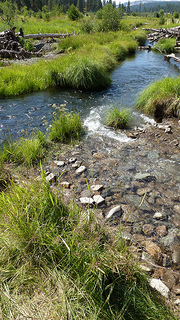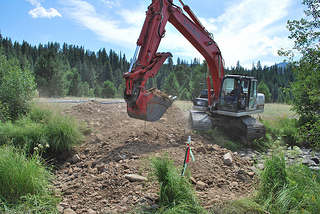On July 26, more than 90 project staff and volunteers turned out to the Upper Middle Fork John Day to remove fish and other fauna from a 3,400-foot ditch that was dug in the 1940s due to mining activities. The artificial ditch reduced flows during summer months, which had a negative impact on the fish.

Crews dewatered the section of ditch and removed it to restore the site to pre-mining conditions. Salvaged fish and wildlife were moved to the Middle Fork John Day River or the newly constructed 1,200-foot section of Granite Boulder Creek. The improvements give returning fish more and improved spawning grounds, and it provides a better environment for juvenile fish to thrive before making their trek to the Pacific Ocean. See more photos from this day.
Fork John Day River or the newly constructed 1,200-foot section of Granite Boulder Creek. The improvements give returning fish more and improved spawning grounds, and it provides a better environment for juvenile fish to thrive before making their trek to the Pacific Ocean. See more photos from this day.
This is the second phase of a restoration project in the Oxbow Conservation Area, a 1,022-acre property in the north central Oregon owned by the Confederated Tribes of Warm Springs. The project focuses on habitat protection and enhancement that benefits habitat for spring Chinook salmon, steelhead, bull trout and other species. Efforts include extensive tree and shrub planting, floodplain and river channel restoration, correction of fish passage problems, weed control and irrigation usage.
The project is one of several supported under BPA’s Columbia Basin Fish Accord agreement with the Warm Springs Tribe, and is sponsored by Ecotrust, National Oceanic and Atmospheric Administration (through the Columbia River Intertribal Fish Commission), Pacific Coastal Salmon Recovery Fund, U.S. Bureau of Reclamation, U.S. Fish and Wildlife Service, Watershed Enhancement Board and Bonneville Power Administration.
See more about this project or watch a video: